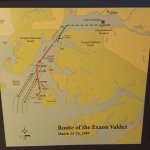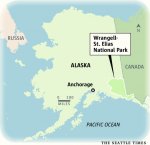Oh Alaska, you just keep getting better and better. I woke up here. That's not bad is it?

I hope you like history, because I've been learning a lot.
But first, when I arrive at a port town, I go find a harbor. I went down to the water front and not only did I find many vessels I had never seen before, but I also saw this one, which I had seen before. On the television. Deadliest Catch fans will recognize it/


So this day, Valdez is fairly well socked in. None of the what I can assume are lovely mountains are really visible, though they're giving tantalizing little clues as to their grandeur. Evident also are the numerous waterfalls trickling down off of the peaks. After a walk down every single dock in the harbor it starts to rain for real. We are already off to a pretty late start after the previous travel day and meandering around the docks, so by the time we get around to the Valdez Museum, it's only open another hour. But we can get a lot done in an hour if I must.
Before we go any further, I chose Valdez as a sort of “goal” destination for the northern part of this trip because this is an environmental program afterall, and I've just recently turned 29, and the Exxon Valdez oil spill was 29 years ago. Rather than show you trash pictures, allow me to learn you up on some oil spill knowledge, because that's often times what the name Valdez conjures up. Valdez as some of you may know is the bottom of the Trans-Alaska Pipeline. It received the first barrel of oil through the pipeline on July, 28 1977. (It did as you can see from the snippet above get a barrel just before that by dog sled). It is the country's northernmost ice-free port, and therefor very important to this end. This strategic location was also very important for the town's early days. More on that later.


March 23, 1989. The tanker ship Exxon Valdez sails from the Marine Terminal towards Prince William Sound with 53 million gallons of crude oil. She is sailed out by license coastal pilot, Ed Murphy with Captain Joseph Hazelwood present on the bridge. Past Rocky Point, Murphy leaves, and Hazelwood is in control. Ice had been reported in the sound, and Hazelwood radios the Coast Guard that he may divert into the inbound traffic lane if it's clear of traffic to avoid the ice. He then does so, intending to skirt around towards Bligh reef before cutting back to the lanes.
Here's where he went wrong. He then, before this maneuver was finished, handed control of the ship over to Third Mate Gregory Cousins with instructions to return to the southbound lane after passing the Busby Island Light. Then he leaves the bridge. The report is that he was also drunk while below decks. Cousins was not certified to pilot the ship north of Bligh Reef. The lookout twice warned the bridge the course was incorrect. At midnight, the ship makes one last turn to correct, but at 12:04 on Good Friday the ship strikes the reef. The impact punctured 8 of the ship's 11 tanks, spilling 5.8 million gallons of oil in just the first three and a bit hours.
I apologize if my phone pics from inside the museum are a little fuzzy, low light and all.


There were a couple reasons it got as bad as it did. The first was just the sheer quantity that escaped the ship so quickly. Exxon maintains that 10.8 million gallons were spilled, some estimates put that number closer to 38. Whatever the real number was, the cleanup was poor. It's challenging in any spill to reach 100% containment, but in the beginning of this spill the response times were dismal. A combination of lack of resources and a poor inter agency understanding of jurisdictions meant that many hours went by before anything was on the scene to do anything about it, and even then, the process was inefficient. By the time of the 27th, the window of opportunity they had to contain it was gone and a 70mph storm blew the oil out of the Sound and into the Gulf of Alaska. Now it was a scramble to catch up. Ultimately because of all this, the oil ended up traveling 490 miles from where the ship ran aground and affected some 1,300 miles of coastline.

The impact on local wildlife, hatcheries, and sensitive areas was profound and many species are still recovering, some have not. Estimated casualties include 250 to 500 thousand seabirds, 2,800 to 4,000 sea otters, 300 harbor seals, 250 bald eagles, up to 22 killer whales. Fish deaths are harder to manage, but possibly billions of herring and pink salmon eggs. How many species rely upon things like herring as a food source? Up to 50% of the 1,600 birds brought in for treatment died while getting it, and high mortality was suspected of those released back into the wild as well.
Did any good come of this after? Well, since then because of strict policies now regarding shipping in and out of the area, over 11,000 tanker escorts have passed through without incident, and Prince William Sound is now one of the most protected environments in the world, absorbing nearly 1/3 of the U.S. Spending for oil spill prevention and recovery. There's also better training, technology and planning in place for a possible spill.
Legal compensation is a tricky subject because while $5 Billion had been awarded to the local fishermen, natives, and landowners who filed a class action law suit, it didn't really work out that way. Between 1994 and 2008, the suit went though many appeals and the Supreme Court eventually ordered Exxon to pay just $507.5 million. However in this time, nearly 20 years since the spill, more than 3,000 of the original claimants had passed away before that ruling came.
Environmentally, on the surface at least, it seems to have mostly recovered. This is harder to judge because perhaps only 10% of the spilled oil was ever recovered. Much of it sank because it was cold and will be slow to disperse, and there were reports even as recently as a few years ago that there was still oil just under the rocks on some of the beaches. As I said before, some species to this day are still in the process of recovering and some never did. It's also a good time to point out that as bad as the spill was in terms of contamination from a one time event, it's still dwarfed in general by other slower means like natural seepage and leaked from automobiles and boats for sheer volume over time as you can see here.

Which is why when the internet said “The 4.0L just leaks, they all do that.” I said, but they don't have to, and did the bottom gaskets anyway. And it doesn't.....power steering fluid yes, but very slowly. It's a work in progress, nobody's perfect.

























































































